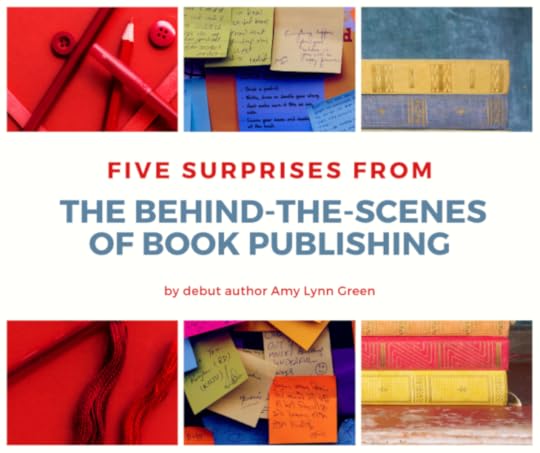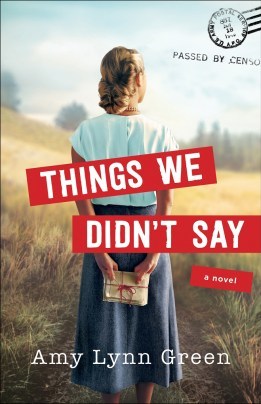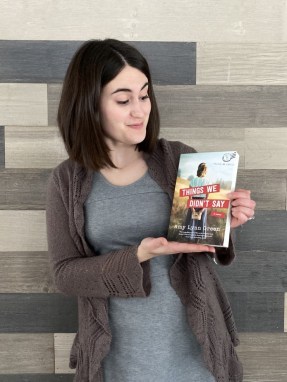Five Surprises in Book Publishing with Amy Green

Hello, readers! My name is Amy Lynn Green, and Karen Witemeyer invited me to share with you to celebrate the release of my debut novel. Things We Didn’t Say follows Johanna Berglund, the witty and slightly blunt translator for a camp for German prisoners of war in Minnesota during WWII. And it’s an epistolary novel, meaning that it’s written entirely in letters, newspaper articles, telegrams, and other documents.
I’ve worked in publishing for eight years, so I thought I wouldn’t find many surprises when switching to the “other side of the desk.” I knew all of the fancy terms and acronyms, experienced most of the marketing process, and had even toured the printing press to pick up a book from the line while the binding glue was still warm to the touch. Nothing more to learn, right? Boy, was I ever wrong! Here are five new things I’ve learned already as an author.
One: Audiobook narrators know how to pronounce more words in a book than the author.
When Leah Horowitz, the narrator for the audiobook of Things We Didn’t Say, contacted me, I knew I had to interview her to learn more about the recording process. I’ll be sharing snippets of that interview on Instagram, but my favorite fun fact was that before recording, she reads the whole novel and makes a list of words she doesn’t know how to pronounce. Then, the audiobook’s research department digs in and sends her a list of phonetic pronunciations.
Because my book has occasional snippets of Japanese and German, she had a lot of work to do! I know I can’t say “Wo sich Fuchs und Hase gute Nacht sagen” correctly. (That means “where the fox and rabbit say good-night” in German, meaning the middle of nowhere. Isn’t that a lovely phrase?)
Two: Many books hit a snag in the cover creation process.

For mine, all of the marketing and editorial team members at the cover meeting loved a particular background option, but when the designer went back to her desk, somehow, in the half-hour meeting, another group had purchased exclusive rights to the image. Guess who? CANADA. (Okay, more specifically a Canadian tourism company, but I like to blame the whole country for dramatic effect.) The designer was able to find a similar image, and all was well in the end.
For other covers, designers have had to erase unexpected tattoos from a Regency lady’s arms or substitute the model’s straight hair for an employee’s curly hair when the author changed it during revisions. This supports my belief that designers have a special artistic magic. (I also host cover creation videos on Bethany House’s Instagram page about once a month—if you’re interested in learning more about the cover design process, you should take a look at them!)
Three: Designing the interior of a book is hard work.
We all notice the dramatic design work of covers, but have you ever thought that someone has to style all of the interior pages of a book too? Since Things We Didn’t Say is written entirely in letters, the Bethany House interior design team gave it the award of Most Time-Consuming
Fiction Book Ever. Why? Well, most novels have little flourishes between scenes and maybe a fancy font for chapter headings. Mine had: handwritten letters, crossed out text, telegrams, footnotes, censored sections, date headings, typewritten interview transcripts…and more. That’s a lot to keep straight!
Four: Writing 20th century historical fiction means you can talk to eyewitnesses.
It was a great experience to read dozens of actual letters from WWII, including several kept by family friends, but sometimes my research became even more hands-on. One of the fun surprises in researching this book was that Jerry Yoder, a director of the Camp Algona POW Museum in Algona, Iowa who gave me a tour, had actually met the German POWs who worked on his father’s farm during WWII. Talk about first-hand experience! And, even crazier, after the book released, my husband’s grandmother told me she had worked in a cannery with German POWs as a young woman—one I had researched and mentioned in my novel.
Five: Deciding who to dedicate a book to is hard.

This felt especially true for my debut novel. There’s so much pressure! After all, the dedication is right there on the first page of the book.
I ended up dedicating this novel to my parents, partly because they’ve supported and encouraged me in every way (personally, creatively, and spiritually), but also because Johanna in Things We Didn’t Say has two completely healthy and well-adjusted parents, which is pretty rare. I mean, think about the main characters in the last few books you’ve read. Probably not many of them had a caring mother and father who were both still alive at the start of the story. I figured, since I may never get this chance again in future books, it would be a good one to dedicate to Mom and Dad.
I hope a few of these facts surprised you too. It’s been a fun adventure so far! If you’d like to stay in touch with me, I’d recommend subscribing to my newsletter on my website. (I’ll soon be sending a bookish Christmas gift guide, packed with gems like literary sticky notes, Jane Austen tea, a subscription of watercolor-illustrated letters, and Shakespearean magnetic poetry.) Or, I’d love to have you join me on Facebook or Instagram, where I share book reviews, behind-the-scenes publishing facts, and pictures of absurdly early Minnesota snow.
Giveaway!
I’m also going to give away a copy of Things We Didn’t Say to a random commenter on this post. So here’s your chance—to enter, just comment with a question about my book or the book publishing process in general. I’ll show up to answer as many as I can!
 newest »
newest »
 I loved that it got the Most Time Consuming Novel award...that’s big stuff right there! I can’t wait to read this! What was the most interesting fact you discovered while researching POW camp life?
I loved that it got the Most Time Consuming Novel award...that’s big stuff right there! I can’t wait to read this! What was the most interesting fact you discovered while researching POW camp life?



